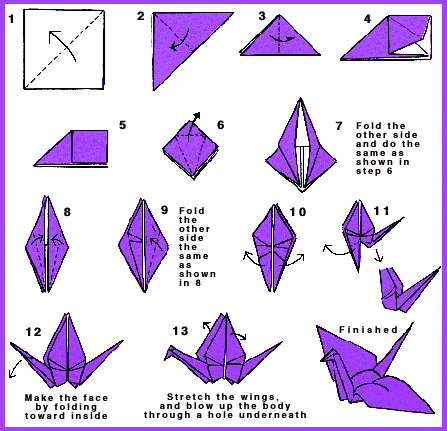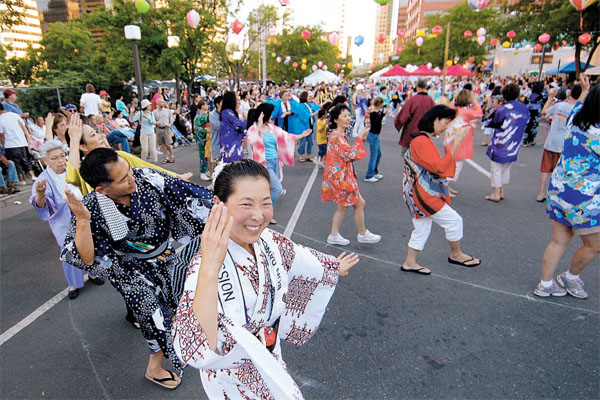1001 Paper Cranes
In Japanese tradition, it is supposedly good luck to have 1001 paper cranes when you get married. Paper cranes are made by intricately folding a square piece of paper in a series of specific steps. It is a Japanese art form known as origami. Typically the bride and groom do not make the paper cranes. Friends and family usually all join together to help make the cranes because it takes quite a bit of time to fold 1001 cranes and the end product is usually a gift to the newlyweds. The cranes can be made in all different sizes and out of all different colors of paper and all the cranes do not have to be uniform. Usually the size and color of the paper used to make the cranes depends on how the paper cranes are going to be displayed at the wedding. The paper cranes can be displayed in really any way and people have gotten very creative with the display of the cranes. For example, my mother told me that at my Aunts wedding the paper cranes were all made out of white paper and her bridesmaids strung all the cranes onto white thread, using knots to evenly separate the cranes on the string and hold them in place. Then they got a tree branch and spray painted it white, and draped/arranged the cranes on the string in the branch so that it looked like a small willow tree filled with white cranes. For my uncles wedding, his friends and his fiancees friends folded paper cranes using red, black, and gold paper, and then with the paper cranes lying flat, arranged them into the family mon, which means crest in Japanese and had the arrangement framed.
Paper cranes are not only made for weddings. I remember I used to make paper cranes just for fun with my mom and my grandmother. My mom was the one who originally taught me although I dont remember exactly how or why she taught me. I probably learned or was taught to make paper cranes as a way of establishing cultural identity. I know my grandmother really liked teaching me Japanese things like words, customs and traditions. I suppose she enjoyed being able to teach her grandchildren about their culture and make sure that we grew up a sense of our Japanese identity.
Paper cranes are also part of the popular art form of origami and is cited in various works. For example, paper cranes have come to symbolize peace because of a widely published book called Sadako and the Thousand Paper Cranes. I actually remember reading this exact book when I was in elementary school. The book is based on the true story of a young Japanese girl named Sadako Sasaki who was born in 1943. The atom bomb was dropped on Hiroshima, Japan on August 6, 1945, when Sadako was two years old. People who knew Sadako say that growing up she was a strong, courageous and athletic girl. Sadako was a runner but in 1955, at age 11, while practicing for a big race, she became dizzy and fell to the ground. She was diagnosed with Leukemia, also known as “the atom bomb” disease. After her diagnosis one of her best friends told her of an old Japanese legend which said that anyone who folds a thousand paper cranes would be granted a wish. Sadako hoped that the gods would grant her a wish to get well so that she could run again. She started to work on the paper cranes and completed over 1000 before dying on October 25, 1955 at the age of twelve.
To the left is Sadako, pictured at age 12 (1955) and to the right is Sadako’s monument in Hiroshima, Japan.
Annotation: Coerr, Eleanor. Sadako and the Thousand Paper Cranes. New York: The Penguin Group, 1977.
The next few pages have pictured instructions on how to make paper cranes and example of them. Below is a step by step diagram with instructions on how to fold a paper crane.
To the left is a picture of a paper crane that was made but is folded to that is flat. Below is an example of a family crest that was made by putting together 1001 paper cranes (flat) similar to the one pictured to the left
Weddings are often full of folklore because they surround the liminal period or mark the transition of a couple from dating to being married. Wedding are also a very special and joyous occasion in many cultures. It is also a pretty big deal in many cultures and isnt something taken too lightly (one indicator cold the the great amount of time, money and energy that normally go into them) which could explain why there are so may superstitions and or rituals involved that are supposed to bless the marriage or bring the marriage good luck. Just like the 1001 paper cranes are supposed to bring good luck, I have heard other superstitions such as the groom cant see the bride before the wedding, or the bride has to wear something, old something new, something borrowed, and something blue.






